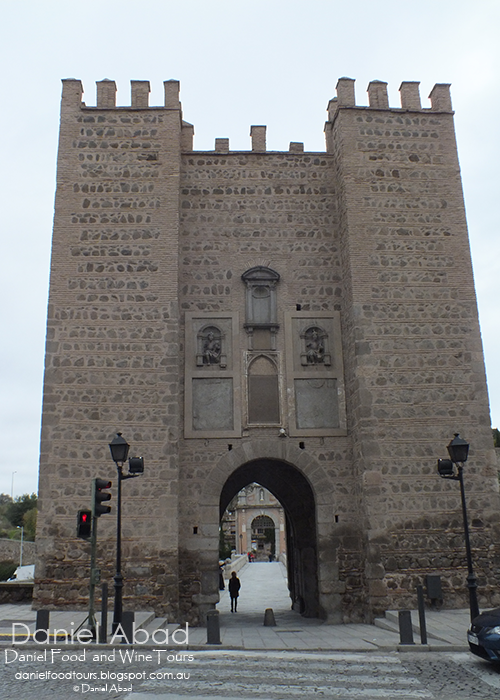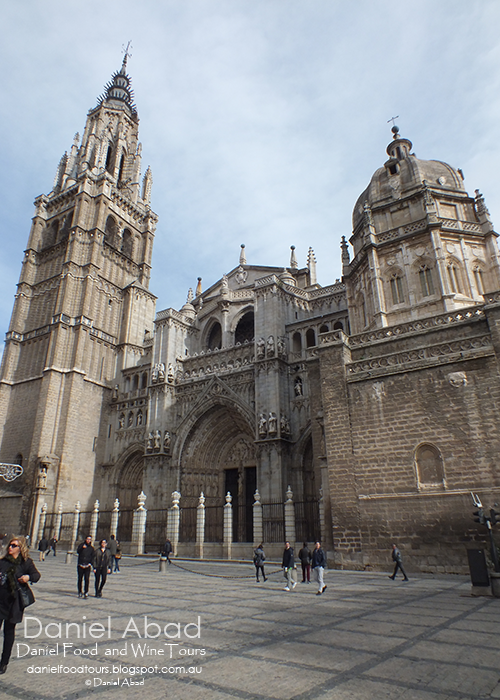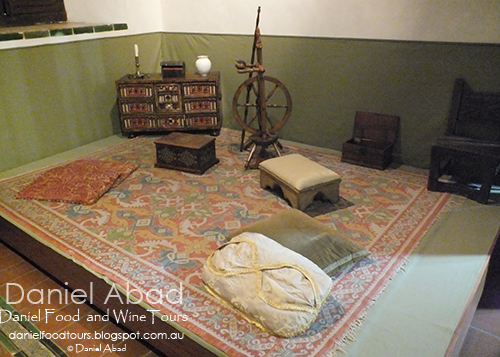Ever
since my Mum gave me a pair of Toledo cuff links some forty odd years ago, I
had always wanted to visit this very special place. In November 2016, I finally had this
opportunity. I only spent one day in
that amazing city on my way to the northern part of Spain but it was a day full
of surprises and delight. I discovered medieval wall, a labyrinth of
winding cobblestone streets
and magnificent old stone buildings; all of these, a legacy of the illustrious
past of this unique place.
 |
| Daniel Food and Wine Tours - My Cuff Links |
Toledo is located on a mountaintop, surrounded on three sides by
a bend in the Tagus River. Often referred to as the heart and soul
of Spain, it is a city located in central Spain and the capital of the province
of Toledo. It is one of the Spanish
cities with a wealth of monuments; churches, palaces, fortresses, mosques and
synagogues. Known as the “city of the
three cultures”, it was declared a World Heritage Site by UNESCO in 1986 for
its extensive cultural and monumental heritage as well as its historical
co-existence of Christian, Muslim and Jewish cultures which lasted for
centuries. This great diversity of
artistic styles makes the old quarter of this city - La Mancha a real open-air
museum. It contains many historical
sites, including the Alcazar, the cathedral and the Zocodover, a central market
place.
 |
| Daniel Food and Wine Tours - Toledo |
 |
| Daniel Food and Wine Tours - The River Tagus |
The city of Toledo has its
origins in Toletum,
the name the Romans gave to this settlement on the banks of the River Tagus
after its conquest in 190 BC. The Roman
circus in Toledo was one of the largest in Hispania. Chariot races were held on special holidays
and were also commissioned by private citizens to celebrate special
occasions. The circus could hold up to
15,000 spectators. Today the historic
centre is full of basements, passages, wells, baths and ancient water pipes
that have been used in the city since Roman times. The city maintained its importance for
centuries and, during the Visigoth era, it became the capital of Hispania until
the Moors conquered the Iberian Peninsula in the early years of the 8th
century.
 |
| Daniel Food and Wine Tours - The narrow streets of the Old Toledo |
With the arrival of the Moors, together with the presence of Christians and Jews, Toledo went through one of its most splendid periods and became a main centre of literacy and writing in the Iberian Peninsula. Among other important events, the Toledo School of Translators was founded.
 |
| Daniel Food and Wine Tours - One of the entries to the Old Toledo |
 |
| Daniel Food and Wine Tours - The Moorish Heritage is everywhere |
Toledo took a central position in the struggles between the Muslim and Christian rulers of northern Spain. The conquest of Toledo by Alfonso VI of Castille in 1085 marked the first time a major city in Al-Andalus was captured by Christian forces. After the conquest, Toledo continued to be a major cultural centre; its Arab libraries were not pillaged, and a translation centre was established in which books in Arabic or Hebrew would be translated into Castilian by Muslim and Jewish scholars, and from Castilian into Latin by Castilian scholars, allowing all this vast amount of knowledge to spread throughout Christian Europe.
Charles I of Spain's court was set in Toledo, serving as the imperial capital. However, in 1561, in the first years of his son Philip II of Spain, the Spanish court was moved to Madrid, thus letting the city's importance dwindle until the late 20th century. The economic decline of the city helped to preserve its cultural and architectural heritage. Today, because of this rich heritage, Toledo is one of Spain's foremost cities, receiving thousands of visitors every year.
Standing watch over the city, the Alcázar has a commanding presence on its hilltop location. This ancient Moorish fortress was built on the site of an earlier Roman fort. The Alcazar became renowned in the 19th and 20th centuries as a military academy. During the Spanish Civil War, the Alcázar was used as a Nationalist garrison. At the outbreak of the war in 1936, the garrison was besieged by Republican forces. It is considered as a monument to the heroism of Franco supporters. The Alcazar has been restored and now houses an Army Museum with exhibits about the Civil War.
 |
| Daniel Food and Wine Tours - The Alcazar |
One of the most outstanding buildings in the city is its Cathedral, considered one of the high points of Gothic art. The construction of this monumental building, began in 1226, but it was not finished until the 15th century. With its soaring tower, the cathedral is one of the most important Christian landmarks in Spain. It was built on the site of a Muslim mosque next to the Judería (Jewish quarter). The exterior is somewhat crowded by the tightly packed buildings surrounding it, but the interior is simply breathtaking.
 |
| Daniel Food and Wine Tours - The Toledo Cathedral |
 |
| Daniel Food and Wine Tours - The Statue of Cervantes the Author of Don Quijote de la Mancha |
The famous master of Spanish painting, Doménikos Theotokópoulos was born in Crete in 1541, and in 1577, he came to Spain where he was simply called El Greco ("The Greek"). The Casa El Greco in the Jewish quarter near the synagogue is the house where El Greco is known to have lived.
 |
| Daniel Food and Wine Tours - El Greco's House and Museum Nearby |
 |
| Daniel Food and Wine Tours - The View From El Greco's House |
Renovated in 1906, the building is decorated with furniture and sculptures that belonged to El Greco. In the adjoining building is the Museo El Greco. On the first floor are three rooms containing more than 20 works by the Master. There are many more masterpieces by El Greco displayed throughout the city's churches and convents.
 |
| Daniel Food and Wine Tours - Inside El Greco's House |
El Greco's style...
 |
| Daniel Food and Wine Tours - The Unmistakable Faces of El Greco |
Elongated faces and fingers, deep dark shadowing...
 |
| Daniel Food and Wine Tours - El Greco's Hand Technique |
The metal-working industry has historically been Toledo's economic base, with a great tradition in the manufacturing of swords and knives and a significant production of razor blades, medical devices and electrical products. Soap and toothpaste industries, flour milling, glass and ceramics have also been important.
 |
| Daniel Food and Wine Tours - Toledo Swords |
Toledo’s steel-working industry goes back to about 500 BC. It soon became a standard source of weaponry for Roman Legions. It was however under Moorish rule and during the Reconquista that Toledo and its guild of sword-makers played a key role. Between the 15th and 17th centuries the industry enjoyed a great boom, to the point where its products came to be regarded as the finest in Europe. In the late 17th and early 18th century production began to decline, prompting the creation of the Royal Arms Factory in 1761 bringing together all the sword-makers guilds of the city.
 |
| Daniel Food and Wine Tours - Toledo Swords |
In the 20th century, the production of knives and swords for the army was reduced to cavalry weapons only. Today, many shops offer all kinds of swords as well as medieval armours to their customers. They are also exported to other countries.
 |
| Daniel Food and Wine Tours - Toledo Armour Work |
 |
| Daniel Food and Wine Tours - Other samples of Toledo's Armour work |
Toledo's cuisine is, well-set in its traditions and closely linked to hunting and grazing. A good number of recipes are the result of a combination of Moorish and Christian influences. This cuisine has various specialties based on game products, like stewed partridge, Toledo-style quail or venison with wild mushrooms. With the other provinces of La Mancha it shares pisto (based on pepper, tomato and onion), Castilian soup and migas (dish made with breadcrumbs and pork products). These dishes may be accompanied with the wines of La Mancha. Two of the city's most famous food productions are Manchego cheese and marzipan (made from ground almonds and sugar).
 |
| Daniel Food and Wine Tours - Lentils and Venison, Delicious!! |
 |
| Daniel Food and Wine Tours - Ham & Smallgoods galore |
Leaving Toledo late that afternoon, I felt a strong sense of having fulfilled a dream. Was it because I had at last come to visit this city? Was it the overwhelming sense of History and the glory of the place? Could it have been the works of El Greco? Toledo was a place I simply had to come to. I now have passed on the cuff links to my son and I hope he too will visit Toledo one day and feel the way I did. Who knows? We might even visit it together. That would be nice.






















No comments:
Post a Comment